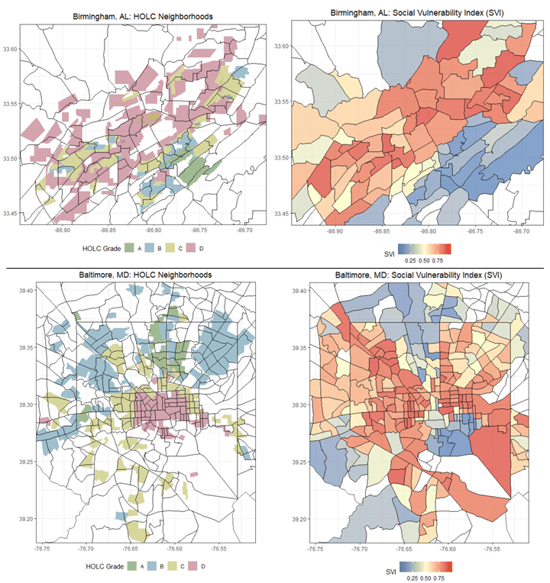Read complete document:
https://www.meridian.org/wp-content/uploads/2020/10/COVID-19-Recovery-Risks-Report.pdf
|
|
||||
Climate Change Could Make Borrowing Costlier for States and Cities
A woman walks along a flooded street in Miami Beach, Florida. Miami-Dade County has been praised by analysts for its infrastructure investments focused on climate preparedness as credit ratings firms begin to focus on climate change. Lynne Sladky/The Associated Press
Someday soon, analysts will determine that a city or county, or maybe a school district or utility, is so vulnerable to sea level rise, flooding, drought or wildfire that it is an investment risk.
To be sure, no community has yet seen its credit rating downgraded because of climate forecasting. And no one has heard of a government struggling to access capital because of its precarious geographical position.
But as ratings firms begin to focus on climate change, and investors increasingly talk about the issue, those involved in the market say now is the time for communities to make serious investments in climate resilience — or risk being punished by the financial sector in the future.
“We look not just at the vulnerability of state and local governments, but their ability to manage the impact,” said Emily Raimes, vice president with Moody’s Public Finance Group. “While we’ll be looking at the data on rising sea levels and who may be more vulnerable, we’ll also be looking at what these governments are doing to mitigate the impact.” Moody’s has been especially vocal about its climate change concerns. The firm has issued numerous papers assessing climate risk, and two months ago it purchased a majority stake in Four Twenty Seven, a climate-risk data firm. Emilie Mazzacurati, Four Twenty Seven’s founder and CEO, said that the bond sector’s attention to the issue should prompt local governments to make it a priority. “It creates an incentive for them to be better prepared, because it’s going to cost them money if they don’t.”
Cities Borrow Big to Pay for Infrastructure State and local governments depend on municipal bonds to finance two-thirds of their infrastructure projects, and analysts are starting to consider how the bond market should adjust as its issuers face increasing risks because of climate change. But some worry that punishing places for their susceptibility to climate change will just make it more difficult for them to finance the infrastructure improvements that might protect them. “Nobody has yet been penalized for having a bad environmental policy or practice or system,” said Tim Schaefer, California’s deputy treasurer for public finance. “I don’t know how much longer that’s going to go on. I’m assuming not much longer.” Assessing Florida’s Future Governments large and small rely on the $3.8 trillion municipal bond market for much of their infrastructure work. When officials want to build a highway or a school — or a seawall or an emergency operations center — they often issue bonds, bringing in the money needed to complete the project. Investors are repaid with interest over a period that can run for decades or more. About two-thirds of infrastructure projects in the United States are paid for by municipal bonds, and more than 50,000 states, local governments and other authorities have issued bonds to finance their work. Governments pay higher interest rates on those bonds when their credit ratings are low. Firms such as Moody’s Investors Service and Standard & Poor’s Financial Services issue the ratings assessments. “Investors are in a position of demanding a higher return when they see greater risk,” said Kurt Forsgren, managing director of S&P Global Ratings. Municipal bonds are considered a conservative investment, with a current default rate of around 0.3%, according to Matt Fabian, a partner at Municipal Market Analytics. To date, the bond market has done little to reflect that the risk may be increasing. “There is almost no impact on muni bond prices with respect to climate change vulnerabilities. Prices do not acknowledge the risk in climate change,” he said. As more investors and firms study the risks, however, that might change. “We are about a year away from climate change beginning to affect the muni market — a little,” Fabian said. “Changes on the investor side are going to happen first, [credit] ratings will come second, and issuer behavior will be a distant third.” Some investors already have begun to factor climate change into their decisions. Eric Glass, a portfolio manager with AllianceBernstein, said his portfolio opted to steer clear of a recent three-decade bond in the Florida Keys, which is facing rising sea levels. “What does [the Florida Keys] look like in 30 years?” Glass said. “I don’t know. But I know it’s not going to look like what it looks like today. That is a tough calculus to make, and we’ve decided not to take it.” David Jacobson, vice president of communications for Moody’s Public Finance Group, called a downgrade over climate projections a “what-if type of thing.” Moody’s ratings are based on what its analysts expect a government’s creditworthiness to be in the next 12 to 24 months, he said, even though the bonds they issue can run for decades. “The things that are happening right now or in the next 24 months weigh a whole lot more than things we think will happen in 15 to 20 years,” said Lenny Jones, a managing director at Moody’s. “We’re not scientists.” Credit-rating firms have always acted conservatively, said Justin Marlowe, a professor at the University of Washington who studies public finance. To some critics, that reluctance to downgrade pre-emptively is leaving the market unprepared for the onslaught of climate effects that so many local governments will face. That’s the conundrum facing the municipal bond market right now: If the market fails to be proactive about future risks, it could lead to billions in ill-fated investments in communities at the forefront of climate change. But making it more expensive for governments with environmental liabilities to borrow money could prevent them from making the improvements needed to strengthen their infrastructure. And just because a city is likely to be struck by sea level rise or wildfire doesn’t necessarily mean it will default on its bonds. Further effects like crop yields and population shifts — and their impact on a tax base — could prove even harder to project. “It’s a pretty big step from ‘we have economic impacts’ to ‘this is going to affect their long-term ability to repay their bonds.’ There’s a really big difference,” Mazzacurati said. “[Ratings firms’] focus is really about counties who repay their debt. That’s it. There can be really important impacts that are not going to be reflected in the bond rating, and that doesn’t mean the bond rating is off.” Disaster Fallout So far, the few climate-related credit downgrades have come after specific disasters. New Orleans and Port Arthur, Texas, experienced credit downgrades after major hurricanes. And after a fire nearly destroyed Paradise, California, last year, the pool of pension obligation bonds it was a member of saw its credit downgraded. As New Orleans rebounded, its credit improved. The city adopted a resilience strategy, bolstered its levee system and pursued other projects, such as turning green space into water reservoirs during periods of flooding. Today, the city sees its biggest climate threat as extreme rainfall, which has increased in frequency in recent years and flooded parts of the city. Leaders in New Orleans are asking voters to approve $500 million in new bonds, which would pay for infrastructure improvements such as the replacement of outdated pipes, as well as other goals like affordable housing. City officials say it shows New Orleans is “doubling down” on its infrastructure program. “The environment is changing. More water’s coming down in a shorter period, and we have to respond to that,” said Norman White, the city’s chief financial officer. “Our first responsibility is to the citizens of New Orleans. Fortunately, that lines up with investors.” Coastal cities across the country are building seawalls to stave off rising oceans. Others are elevating roadways to prepare for more frequent flooding. Some are requiring sturdier new construction and retrofitting existing buildings to withstand severe weather events. Communities in drought-prone areas may focus on projects such as water storage, while those with flooding concerns must fortify their sewage infrastructure. Last year, Moody’s surveyed the 50 largest U.S. cities; 28 responded. Among them, they had 240 climate resilience projects, totaling $47 billion. Some 60% of the projects were to combat flooding. Florida’s Miami-Dade County has been praised by analysts for its infrastructure investments focused on climate preparedness. Ed Marquez, the county’s deputy mayor, said future financing is a “concern,” but officials are trying to address that with capital plans focused on dealing with the changing climate. “This is a many-year process as we fix our infrastructure, as we add new infrastructure, as new science comes on board,” he said. “Miami is still growing. People are still coming. Investors are buying our bonds. We’re telling them what the odds are, but it’s odds that they’re willing to play.” Statewide, Florida remains in good shape creditwise, despite the challenges many of its communities are facing. Ben Watkins, the state’s director of bond finance, said that’s likely to continue, even amid hurricanes and rising sea levels. Even the most devastating hurricane seasons have ended up being a “blip on the radar” in terms of Florida’s credit health, he said. But concern remains for smaller governments within the state. “People are dying to come to Florida and coming to Florida to die,” he said. “Until that changes, we’ll have the economic engines to be able to access credit.” Cities with climate change risks should follow Florida’s lead and borrow now for local projects, said Fabian, the analytics researcher. “As investors get smarter about climate change risk, it will become more expensive for governments with the largest need to borrow,” Fabian said. “Their costs to borrow could certainly be higher. Acting earlier is almost always cheaper.” |
In the 1980s, a set of historical city maps resurfaced to reveal a hidden facet of our neighborhoods—the redlined status. As it turns out, the implementation of these maps saved the housing sector and bolstered prosperity for some demographic groups but increased disparities in homeownership, wealth, and health for others.
The structural inequalities set in place by federal policies over 80 years ago are still evident in communities today. As our nation continues to fight the COVID-19 pandemic, the historic designations of a neighborhood between “hazardous” and “best” continue to parallel inequities in testing, case rates, fatalities, and vaccinations. These historic lessons shine a light on the importance of explicitly including an equity lens for current policy decisions, not only to address current disparities, but the lasting effect decades later.
How did we get here?
In 1933, President Roosevelt created the Home Owners’ Loan Corporation (HOLC) with the goal of bolstering a failing housing market during the Great Depression. The plan was to refinance home mortgages and expand home buying opportunities for Americans.
In order to do this, the Home Owners’ Loan Corporation evaluated over 200 cities in the U.S. for neighborhoods of “mortgage security,” using data from local lenders, developers, and real estate appraisers. Each city’s neighborhood was graded on a four-level system:
When classifying neighborhoods, evaluators didn’t just look at current housing quality and rent and sale values, but also the color of the residents’ skin. In Birmingham, Alabama, an area with “executives, businessmen, and retired professional men” was graded as “best” with an A rating, while an adjacent neighborhood described as a “negro low-cost slum clearance project” was redlined with a D grading.
HOLC grades were then adopted by private and public entities and became an essential component of housing sector decisions up until the 1970s. Over the course of these decades, the practice of redlining stymied the ability of residents in redlined areas—most of whom were Black Americans—from building wealth by restricting home ownership and appreciation of home values.
How redlining harmed health
With 89% of health explained by factors outside of medical care, careful attention should be paid to the environment and social circumstances in which people live. Several studies show that living in redlined areas has been linked to severe asthma, birth outcomes, cancer stage at diagnosis, urban heat, and food environments, among other present day adverse effects.
Many of these health conditions also place individuals at increased risk for COVID-19. COVID-19 comorbidities are more prevalent among communities of color, and these populations exhibit higher exposure, positive tests, hospitalization, and death rates in comparison to White populations.
The Centers for Disease Control and Prevention (CDC) Social Vulnerability Index (SVI) scores the susceptibility of communities to disasters or disease outbreaks, such as COVID-19. When comparing redlined maps of Birmingham, Alabama to current maps of social vulnerability scores, there is a clear relationship between redlined areas and socially vulnerable areas, emphasizing redlining’s impact on present day adverse health outcomes.

Figure 1: Data from Mapping Inequality and CDC
Redlined neighborhoods changed by gentrification
Redlining also creates conditions for gentrification, which results in changes to the characteristics of neighborhoods and ultimately has mixed effects on the health of residents.
For example, the HOLC maps of Baltimore (shown in Figure 1) look like a target with concentric rings of improving grades moving outward—and the bullseye is the formerly redlined region. The current SVI map also shows similar patterns of vulnerability to prior HOLC grades. Upon further investigation, there is a subregion within the redlined center that displays surprisingly low vulnerability. That subregion of Baltimore has been subject to a modern form of displacement known as gentrification.
Gentrification is the influx of higher-income, more educated, and mostly White residents into a traditionally low-income, minority neighborhood. Gentrification may increase access to physical and institutional improvements like grocery stores over mini-marts, public parks over empty lots, or coffeeshops over liquor stores. While these changes can improve the living conditions and amenities of neighborhoods, they come at higher costs of living and are not equally accessible to all residents, especially low-income and racial/ethnic minorities.
Why do communities gentrify? Historically redlined areas often exhibit a “rent gap”—the difference between the potential value of the property and the current prices of housing. The prime location of urban housing paired with historical underinvestment and low rent prices make them attractive to young career professionals, developers, and investors looking to capitalize on the gap in property values. In San Francisco, 87% of neighborhoods undergoing gentrification were once redlined as “hazardous.”
Secondary effects of gentrification on health
For legacy residents who remain in their communities, gentrification may lead to new investments and economic opportunities, improving social conditions and health outcomes. However, the higher cost of living, stress, and anxiety from cultural displacement can negate that impact.
Legacy residents who are displaced face tremendous housing instability. Those who find new homes tend to move to similar socioeconomic neighborhoods as their previous community. The costs and stressors associated with moving as well as the disruption to social networks and community ties ultimately lead to negative health outcomes. Recent social connections research shows that limited networks cause greater detriment to health than obesity, smoking, and high blood pressure and increase susceptibility for anxiety and depression.
Additionally, areas undergoing gentrification see an expansion in police presence. While police may signal increased safety for new residents, multiple studies have shown that police interactions have significant associations with poor mental health outcomes, particularly for Black Americans. Recent evidence from a longitudinal study of gentrification in New York notes a trend of increased 311 calls and discretionary arrests, of which young men of color are the primary target.
Acknowledging redlining and gentrification in the era of COVID-19
It is no surprise that COVID-19 has disproportionately affected low-income and minority communities. The U.S. Census Bureau’s Household Pulse Survey has been capturing the status of social and economic impacts of the pandemic. The evidence suggests that housing disparities are further widening by race and income, with Black and Latino renters more likely to miss rent compared to White renters and Black homeowners more likely to defer mortgage payments compared to other groups.
Furthermore, these same groups experience higher incidences of COVID-19, even on a community scale. With the combined pressure from economic and geographical influences, the situation becomes a double-edged sword, exacerbating the disparities in health outcomes especially for minority populations.
Redlining resulted from a federal policy in response to a housing crisis but worsened health disparities for minority communities to this day. As the nation moves forward from this global pandemic, the response through policies and implementation must keep a health equity lens at the forefront to remedying missteps from the past and avoid the same path for the future. The explicit focus from the Biden Administration on advancing health equity is not only essential now to ensure vulnerable populations have equal access to testing, care, and vaccinations in the near future, but also on the health impacts down the line.
**Feature photo by Maria Orlova from Pexels

Hannah De los Santos, PhD, MS, is a Senior Data Scientist in the Model-based Analytics Department at The MITRE Corporation. She earned her PhD in Computer Science and her MS in Applied Mathematics from Rensselaer Polytechnic Institute. Her work seeks to use data analytics techniques to solve problems in health.
 Karen Jiang, MPH, is a Domain Specialist in the Clinical Quality and Informatics Department at The MITRE Corporation. She earned her MPH in Health Policy from Harvard T. H. Chan School of Public Health. Her interests lie at the intersection of health policy, health equity, and data analytics.
Karen Jiang, MPH, is a Domain Specialist in the Clinical Quality and Informatics Department at The MITRE Corporation. She earned her MPH in Health Policy from Harvard T. H. Chan School of Public Health. Her interests lie at the intersection of health policy, health equity, and data analytics.
 Julianna Bernardi, BS, is an Associate Data Scientist in the Model-based Analytics Department at The MITRE Corporation. She earned a Bachelor’s of Science from Wentworth Institute of Technology in Applied Mathematics. She is interested in using mathematics and data visualizations to tell stories and facilitate work in the public interest.
Julianna Bernardi, BS, is an Associate Data Scientist in the Model-based Analytics Department at The MITRE Corporation. She earned a Bachelor’s of Science from Wentworth Institute of Technology in Applied Mathematics. She is interested in using mathematics and data visualizations to tell stories and facilitate work in the public interest.
 Cassandra Okechukwu, ScD, MSN, MPH, is a Principal Health and Life Scientist at The MITRE Corporation. She is a social epidemiologist with over 15 years of experience in healthcare and public health. Dr. Okechukwu’s chief expertise is using knowledge from social and behavioral sciences to inform the design, implementation, and evaluation of programs, policies, and technologies that promote population health.
Cassandra Okechukwu, ScD, MSN, MPH, is a Principal Health and Life Scientist at The MITRE Corporation. She is a social epidemiologist with over 15 years of experience in healthcare and public health. Dr. Okechukwu’s chief expertise is using knowledge from social and behavioral sciences to inform the design, implementation, and evaluation of programs, policies, and technologies that promote population health.
|
Biosafety and Biosecurity Training Course: August
2-6, 2021 |
||||||||||||||||||||||||||||||||
|
||||||||||||||||||||||||||||||||
James Wilson